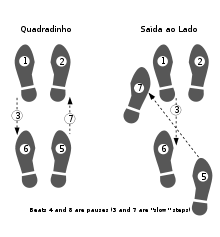Samba de Gafieira
Samba de Gafieira (also called Gafieira) is a partner dance to the Brazilian samba musical rhythms.
Samba de Gafieira must be distinguished from the ballroom Samba, danced in International Latin and American Rhythm ballroom dance styles.
Gafieira is usually a pair dance, although in artistic performances it is not uncommon to add solo variations, including steps of Samba no Pé.
Word meaning
The word "gafieira" can also refer to the traditional samba music orchestra, as well as the dance hall where it is performed. The term gafieira was Brazilian Portuguese slang meaning "low dancing resort, gaff, honky-tonk" or "dance festivity frequented by the populace".[1]
Origins
The style originated fom samba dancing in cabarets and gafieiras (hence the name, literally meaning "Samba of gafieira"), primarily in districts of Botafogo, Catete and Centro of Rio de Janeiro. The term gained recognition in 1940s. Over time the style significantly evolved away from the style 1940s under significant influence of Argentine Tango and incorporating many acrobatic elements."[2]
Beginners' steps

Like Argentine Tango, Gafieira is danced in either open embrace, where lead and follow connect at arms length, or close embrace, where the lead and follow connect chest-to-chest.
Passo basico
Passo basico ("Basic step", sometimes called Quadrado ("box step") or Quadradinho) is a simple beginner's step with rhythm "quick-quick-slow" over 4 beat measure.
It is not really a box step, but rather similar to the "Basic movement" of the international ballroom Samba syllabus, and its 8-beat basis step sequence is performed in reverse, with the leader moving his left foot back on three and his right foot forward on seven.
The lateral movements on one and two and on five and six are almost in place (or sometimes on one moving the left foot slightly forward and on five moving the right foot slightly backward).
Often only a half of the passo basico is used, e.g., as part of other, more complicated step patterns.
Saída Lateral
The Saída Lateral or Saída ao lado (both literally mean "exit to side", "lateral exit", sometimes translated as "right cross body lead") step is used to enter or exit many other more elaborate Gafieira steps.
To execute the figure, start with the first 5 footsteps of the Passo Basico, with the leader's 5th step taken slightly backwards, slightly parting form the follower. The leader's 6th (slow, right foot) step is forward left across the standing foot outside the partner. The follower's 6th step is backward sideways, crossing the left foot behind.
In descriptions of more complicated patterns, "Saída ao Lado" often refers to only the last three described steps.
Syllabus
In 2001, a meeting of teachers took place in Rio de Janeiro, where a common syllabus of main steps for Samba de Gafieira was established, for unified teaching and competitions. The voted syllabus excluded acrobatic steps, i.e., the ones where both feet of a dancer are off the ground. It also excluded steps not characteristic to Brazilian dance. The syllabus is divided into three categories: Nível Básico (Basic Level, or "Bronze"), Nível Intermediário (Intermediate Level, or"Silver"), and Nível Avançado (Advanced Level, or "Gold"). [3]
Samba de Gafieira is not resricted to the syllabus, which only lists steps commonly agreed to be most important. New steps may be created or entries and exits of the described steps modified, provided they preserve the spirit of Samba de Gafieira.
Basic level
- Passo Básico(Basic)
- Saída Lateral (Lateral Parting)
- Tirada ao lado (Lateral Drawing)
- Cruzado (Crossed)
- Gancho (Hook)
- Balanço (Swing)
- Caminhada (Promenade)
- Esse (letter "S")
- Giro da Dama (Lady's Spin)
- Puladinho (Jump)
Intermediate level
- Romário (a soccer player name)
- Tirada de Perna (Leg Taken Off)
- Assalto
- Facão (Big Knife)
- Gancho Redondo (Round Hook)
- Trança (Twist)
- Tesoura (Scissors)
- Balão Apagado (Falling Balloon)
- Picadinho (another Twist)
- Mestre Sala
Advanced level
- Pião (Top, spinning toy)
- Pica-pau (Woodpecker)
- Escovinha
- Bicicleta (Bike)
- Enceradeira
References
- ↑ Michaelis 1992
- ↑ Perna, 2001
- ↑ Steps - Samba de Gafieira
- Michaelis, ed. (1992). Michaelis: Dicionario Pratico Ingles-Portugues Portugues-Ingles. Companhia Melhoramentos de Sao Paulo. ISBN 978-85-06-01600-8.
- Marco Antonio Perna (2001). Samba de Gafieira - a história da dança de salão brasileira. ISBN 85-901965-5-0. 2002: ISBN 85-901965-8-5
- Marco Antonio Perna (2005). Samba de Gafieira - Brazilian Ballroom dancing history.
| |||||||||||||||||